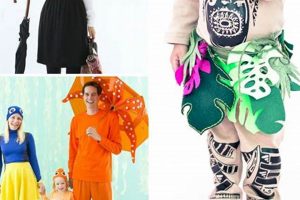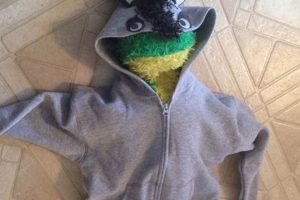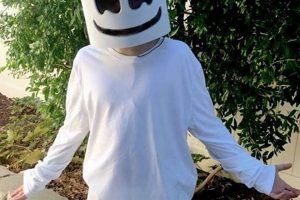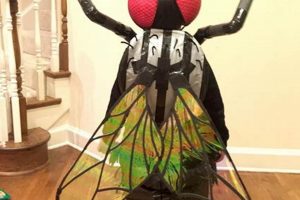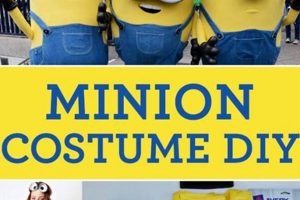Creating a sinister jester guise at home involves a multifaceted approach to design and construction. This process typically encompasses the selection and modification of clothing, the application of makeup artistry to achieve a terrifying visage, and the crafting of props and accessories to enhance the overall effect. An example could involve repurposing a brightly colored thrift store suit, distressing it with artificial tears and stains, and pairing it with exaggerated, menacing makeup and a handmade weapon prop.
The appeal of crafting one’s own menacing jester attire lies in its capacity for individual expression and creative control. This method allows for a unique and personalized interpretation of a classic horror trope, deviating from mass-produced commercial options. Historically, self-made costumes have offered an accessible and resourceful approach to participating in celebratory and theatrical events, fostering ingenuity and artistic skill.
The subsequent sections will delve into specific techniques for designing the garment component, applying effective makeup for a frightening impact, and constructing complementary accessories that complete a truly unsettling character presentation.
Crafting a Sinister Jester Persona
Achieving a convincingly frightening homemade jester appearance requires careful planning and execution. The following suggestions provide a structured approach to constructing each element of the costume.
Tip 1: Garment Acquisition and Modification: Begin with sourcing suitable garments. Thrift stores offer affordable options. Overalls, jumpsuits, or brightly colored suits are potential starting points. Distress the fabric with strategic tears, frayed edges, and simulated stains using diluted acrylic paints or fabric dyes to create a worn and menacing aesthetic.
Tip 2: Makeup Design and Application: Research various malevolent jester makeup styles. Prioritize high-quality face paints or theatrical makeup to ensure lasting color and avoid skin irritation. Experiment with exaggerated features, such as enlarged mouths with sharp teeth drawn on, intensely dark eye sockets, and grotesque smiles. Use setting powder to prolong the makeup’s durability.
Tip 3: Wig Selection and Styling: Choose a wig with vibrant, unnatural colors and consider styling it for a disheveled appearance. Backcombing, teasing, and the application of hairspray can contribute to a chaotic and unsettling hairstyle. Alternatively, consider bald cap makeup with minimal, strategically placed strands of hair for a more disturbing visual.
Tip 4: Prop Construction: Develop complementary props to enhance the character’s menace. A homemade mallet constructed from lightweight materials like PVC pipe and foam, painted with a faux blood effect, can serve as a formidable accessory. Alternatively, create oversized novelty weapons or miniature coffins for added macabre detail.
Tip 5: Footwear Considerations: Select oversized or clown-style shoes to further accentuate the character’s exaggerated features. Paint or modify the shoes to match the costume’s color scheme, and consider adding details such as bells or exaggerated buckles for heightened visual impact.
Tip 6: Accessorizing with Unsettling Details: Incorporate unsettling accessories such as mismatched buttons, tattered ruffs, or stained gloves. These small details can significantly enhance the overall effect and contribute to the character’s disturbing persona.
Tip 7: Testing and Refinement: Conduct a full costume test before any event. This allows for identification and correction of any flaws in the design or application. Ensure freedom of movement and comfort to avoid hindering the performance.
By adhering to these guidelines, individuals can effectively fabricate a unique and terrifying malevolent jester character, surpassing commercially available alternatives in originality and impact.
The succeeding sections will explore ways to further develop the performance and mannerisms associated with the created persona, solidifying the frightening illusion.
1. Makeup Grotesqueness
The successful manifestation of a homemade sinister jester attire relies significantly on the impactful application of makeup grotesqueness. This element serves as a crucial visual cue, immediately signaling a departure from the traditionally jovial image of clowns and establishing a menacing presence.
- Exaggerated Features
A key aspect of makeup grotesqueness involves the deliberate exaggeration of facial features to create a disturbing effect. Enlarged mouths, often extending beyond the natural lip line and adorned with jagged, painted teeth, exemplify this technique. Similarly, the eyes can be made to appear sunken or intensely shadowed, contributing to an unsettling gaze. These amplified features distort the familiar human form, generating unease.
- Unnatural Color Palettes
The selection of unnatural color palettes further enhances the grotesque aesthetic. Instead of traditional clown makeup colors, a menacing jester frequently incorporates sickly greens, cadaverous grays, and stark blacks. The juxtaposition of these colors against the skin creates a visual dissonance, suggesting illness, decay, or an otherworldly origin. This palette contrasts sharply with the expected vibrancy of conventional clown makeup.
- Deliberate Imperfections
In contrast to the often meticulously applied makeup of traditional clowns, a grotesque jester’s makeup embraces deliberate imperfections. Smudges, streaks, and uneven application contribute to a sense of decay and instability. Cracking effects, simulated wounds, and uneven pigmentation further amplify the disturbing impression. These imperfections suggest a degradation of the character’s sanity or physical form.
- Symbolic Imagery
The incorporation of symbolic imagery within the makeup design can heighten the unsettling effect. Depictions of tears, inverted smiles, or sinister patterns like spiderwebs or pentagrams can imbue the character with a malevolent subtext. These visual symbols create a narrative of suffering, madness, or allegiance to dark forces, enhancing the overall sense of dread.
These multifaceted elements of makeup grotesqueness contribute significantly to the creation of a menacing jester persona. By deliberately distorting and defiling the familiar image of a clown, the makeup artist crafts a visual representation of fear and instability, essential for a truly terrifying homemade costume.
2. Garment Distressing
Garment distressing, when applied to a do-it-yourself sinister jester attire, serves as a critical component in conveying a visual narrative of decay, madness, or malevolence. This process involves the deliberate damaging and alter
ation of fabric to simulate wear, tear, and the effects of age or trauma. The connection between garment distressing and the desired aesthetic is direct; a pristine, freshly manufactured garment would inherently contradict the intended portrayal of a menacing character, whose appearance should suggest a troubled past or an unsettling disposition. The meticulous application of distressing techniques can transform a generic piece of clothing into a key element of a convincing and unsettling costume.
The practical applications of garment distressing are diverse. Tears, strategically placed, can suggest violent encounters or prolonged neglect. Stains, simulated using diluted paints or dyes, can mimic the accumulation of grime or even blood, further contributing to the costume’s disturbing narrative. Fraying edges and worn patches create a sense of age and deterioration, reinforcing the character’s unnerving presence. Specific techniques such as sanding, cutting, and bleaching can all be employed to achieve varied effects. For example, the use of sandpaper to wear down the surface of a brightly colored jumpsuit can subtly mute the color and create a texture of age and neglect. Similarly, carefully placed bleach stains can mimic the appearance of chemical burns or other forms of disfigurement. The selection of appropriate distressing techniques depends on the specific character envisioned and the desired level of visual impact.
In summary, garment distressing plays a vital role in realizing an effective do-it-yourself malevolent jester costume. It acts as a visual shorthand, communicating the character’s disturbed nature and unsettling history. While the application of distressing techniques requires skill and careful planning, the resulting transformation significantly enhances the overall impact of the costume. Challenges may arise in achieving a realistic and believable effect; excessive or poorly executed distressing can detract from the overall aesthetic. However, a well-executed application of garment distressing techniques transforms a simple costume into a deeply unsettling experience.
3. Wig dishevelment
Within the construct of a do-it-yourself sinister jester attire, wig dishevelment assumes a crucial role in signifying chaos, instability, and a departure from conventional clown aesthetics. The purposeful manipulation of a wig’s texture and form contributes significantly to the overall unsettling effect, reinforcing the character’s malevolent persona.
- Textural Disruption
Textural disruption involves altering the wig’s surface to create a sense of unkemptness. Backcombing, a technique involving teasing the hair against its natural direction, introduces significant volume and tangling, deviating from a smooth, orderly appearance. This process can be further enhanced by the application of hairsprays and styling products designed to create a matte or gritty finish. The result is a wig that visually suggests neglect or active disturbance, mirroring a character’s internal turmoil.
- Asymmetrical Styling
Asymmetrical styling contributes to wig dishevelment by intentionally disrupting the wig’s symmetry and balance. Choppy cuts, uneven lengths, and deliberately lopsided arrangements create a visual sense of imbalance. This departure from conventional hairstyles suggests a lack of control or a deliberate rejection of societal norms, further reinforcing the character’s unsettling nature. Examples include partially shaved sections, deliberately uneven bangs, or a style that appears to be in the process of falling apart.
- Color Manipulation
While not strictly dishevelment in the sense of texture or form, color manipulation can contribute to the overall effect of a disturbed wig. The application of temporary hair colors, dyes, or even simulated stains can create a visually jarring effect. Streaks of contrasting colors, faded patches, or the application of a muddy or grimy tone can suggest neglect or decay, further enhancing the wig’s unsettling appearance. Consider, for example, a vibrant red wig with streaks of black or brown to simulate dirt or blood.
- Intentional Damage
The most extreme form of wig dishevelment involves intentional damage to the wig’s structure. This can include cutting sections of the wig away entirely, burning the fibers (with extreme caution and in a controlled environment), or physically tearing the wig’s netting. Such techniques create a visceral sense of destruction and can be particularly effective in conveying a character’s violent or unhinged nature. It should be noted that such techniques are irreversible and should be employed with careful consideration.
In conclusion, wig dishevelment encompasses a range of techniques that contribute significantly to the overall impact of a homemade sinister jester attire. By manipulating the wig’s texture, form, color, and even its structural integrity, it becomes an effective visual representation of chaos, instability, and a departure from conventional norms, thus solidifying the character’s unsettling persona.
4. Prop menace
The element of “prop menace” is intrinsic to the effectiveness of a “diy evil clown costume.” It directly contributes to the portrayal of a threatening persona, amplifying fear and unease in observers. The absence of menacing props reduces the costume to a mere approximation, lacking the crucial component that transforms a comical figure into a source of dread. The causal relationship is evident: the presence of such props elevates the costume’s overall impact; their absence diminishes it. For example, a clown wielding a faux bloody mallet elicits a significantly stronger reaction than one without any accessories, highlighting the potency of “prop menace.”
Specific examples of menacing props include oversized, exaggerated weapons fabricated from lightweight materials. Mallets, knives, or axes constructed from foam and painted to appear realistic provide a visual threat without posing actual danger. Alternatively, modified childrens toys can be repurposed to create unsettling effects. A teddy bear with missing eyes and simulated bloodstains transforms a familiar object into a symbol of corruption and decay. The practical application of this understanding lies in carefully selecting props that complement the overall theme of the costume and contribute to a cohesive narrative of menace. This necessitates a balance between visual impact and practical considerations, ensuring the props are manageable and do not impede movement or visibility.
In summary, “prop menace” is an indispensable element in the construction of a convincing “diy evil clown costume.” The deliberate incorporation of threatening accessories significantly enhances the costume’s ability to evoke fear and discomfort. While the creation and selection of appropriate props require careful planning and execution, the resulting effect is crucial in transforming a simple costume into a truly unsettling spectacle. The challenge lies in maintaining a balance between realism and safety, ensuring the props are both visually impactful and practical for wear and display.
5. Footwear exaggeration
Footwear exaggerat
ion constitutes a pivotal design element within the realm of “diy evil clown costume,” significantly influencing the overall aesthetic and contributing to the unsettling persona. The purposeful distortion of shoe size and style serves as a visual cue, immediately deviating from the norm and amplifying the character’s grotesque and unnatural presence.
- Oversized Proportions
Oversized proportions in footwear represent the most common form of exaggeration, involving the selection or modification of shoes that are significantly larger than the wearer’s actual foot size. This creates a comical yet disturbing effect, rendering the character’s gait unsteady and unpredictable. Examples include repurposing clown shoes or altering existing footwear with padding and extensions. The resulting disproportion contributes to the character’s overall sense of unreality and menace.
- Stylistic Amplification
Stylistic amplification entails exaggerating existing shoe styles to an extreme degree. This can involve the creation of shoes with excessively pointed toes, towering platforms, or ludicrously high heels. Such modifications distort the familiar silhouette of footwear, transforming ordinary items into objects of visual discomfort. The application of bright colors, bizarre patterns, and grotesque embellishments further amplifies the effect. For example, platform shoes adorned with miniature skulls or shoes with toes that curl upwards in an unnatural manner.
- Thematic Integration
Thematic integration dictates the incorporation of footwear styles that align with the specific sub-theme of the “diy evil clown costume.” For a more traditional, yet sinister, approach, one might consider exaggerated Victorian-era boots with buckles and laces, emphasizing a sense of corrupted elegance. Alternatively, a more modern interpretation might incorporate platform boots adorned with spikes and chains, reflecting a more aggressive and chaotic persona. The selection of footwear should be carefully considered to reinforce the overall narrative and visual impact of the costume.
- Practical Considerations
While visual impact is paramount, practical considerations cannot be overlooked. Footwear exaggeration should not compromise the wearer’s safety or mobility. Oversized shoes can impede movement and increase the risk of falls. Likewise, excessively high heels or platforms can cause discomfort and instability. Careful planning and construction are essential to ensure the footwear is both visually striking and practical for wear. This may involve reinforcing the shoe’s structure, providing adequate ankle support, and practicing walking in the exaggerated footwear prior to any event.
In conclusion, footwear exaggeration plays a crucial role in defining the unsettling visual impact of a “diy evil clown costume.” Through oversized proportions, stylistic amplification, and thematic integration, the footwear becomes a key component in transforming the character from a comical figure into a source of fear and unease. Attention to practical considerations ensures the wearer’s safety and mobility without sacrificing the desired aesthetic effect.
6. Sinister accessorizing
Sinister accessorizing functions as a crucial augmentative component within the framework of a homemade menacing jester attire. Its effectiveness lies in the capacity to elevate the costume from a generic representation to a uniquely disturbing persona. The addition of carefully selected accessories can transform a standard clown suit into a visual embodiment of terror. The relationship between the costume and its accessories is synergistic; the accessories amplify the pre-existing elements of the costume, contributing to a heightened sense of unease and dread. Consider, for example, the addition of a blood-stained ruff or a collection of mismatched, unsettling buttons to an otherwise conventional clown suit. The integration of these elements shifts the perception from harmless amusement to unsettling menace.
The practical application of sinister accessorizing involves a deliberate selection of items that contradict or subvert the expected norms associated with clowns. Examples include tattered and soiled gloves, miniature dolls displaying signs of dismemberment, or jewelry fashioned from unsettling materials such as bone or teeth. The strategic placement of these accessories enhances the visual narrative of the costume, providing subtle yet impactful details that contribute to the overall sense of unease. Furthermore, attention should be paid to the context in which the costume is presented. The accessories should not only be visually striking but also functionally appropriate for the intended environment. A prop knife, while visually menacing, may not be suitable for certain events or locations, highlighting the importance of responsible and considered accessorizing.
In summation, sinister accessorizing is an indispensable element in the crafting of a compelling homemade menacing jester costume. By deliberately incorporating unsettling details and subversive elements, the accessories serve to amplify the costume’s visual impact and contribute to a heightened sense of dread. The challenge lies in striking a balance between visual effect and practical considerations, ensuring the accessories are both visually striking and contextually appropriate. The careful application of sinister accessorizing elevates the costume from a simple assemblage of garments into a truly unsettling and memorable spectacle.
Frequently Asked Questions
The following questions address common inquiries and concerns related to the creation and execution of a do-it-yourself sinister jester attire. Answers are provided to offer clarity and guidance on this subject matter.
Question 1: Is specialized skill required to construct a convincing sinister jester costume?
While advanced crafting proficiency is not mandatory, a basic understanding of sewing, makeup application, and prop construction is beneficial. Simpler interpretations of the costume can be achieved with minimal skills, focusing on readily available items and basic modification techniques. More elaborate designs, however, demand greater technical ability.
Question 2: What are the essential safety precautions when working on a do-it-yourself sinister jester project?
Safety is paramount. Appropriate protective equipment, such as gloves and eye protection, is essential when using sharp tools, paints, or adhesives. Adequate ventilation is crucial when working with potentially harmful chemicals. Open flames or heat sources should be handled with extreme caution. Prioritize personal safety throughout the entire construction process.
Question 3: What are the ethical considerations when designing a sinister jester costume?
While the intention is to create a frightening persona, it is crucial to avoid elements that could be perceived as offensive or discriminatory. Cultural appropriation, the use of symbols associated with hate groups, and the glamorization of violence should be strictly avoided. Thoughtful consideration of the costume’s potential impact on others is paramount.
Question 4: How does the cost of a homemade sinister jester compare to pre-made alternatives?
A do-it-yourself option can be significantly more cost-effective, especially when utilizing repurposed materials. However, the final cost depends on the complexity of the design and the quality of the materials used. High-quality fabrics, professional-grade
makeup, and custom-made props can significantly increase the overall expenditure. A budget should be established prior to commencing the project.
Question 5: How can one ensure the makeup used is safe for the skin?
Selecting hypoallergenic, non-toxic, and fragrance-free makeup is crucial. A patch test should be conducted on a small area of skin at least 24 hours prior to full application to identify any potential allergic reactions. Remove all makeup thoroughly after use with appropriate cleansers and avoid prolonged wear.
Question 6: How can the homemade costume be made more durable for repeated use?
Reinforcing seams, using durable fabrics, and applying protective coatings to props can significantly increase the costume’s longevity. Proper storage is also essential. Garments should be stored in a clean, dry environment, and props should be protected from damage. Regular maintenance and repairs are necessary to prolong the costume’s lifespan.
The construction of a sinister jester attire demands careful planning, meticulous execution, and a firm commitment to safety and ethical considerations. The information presented aims to provide valuable guidance to those undertaking such a project.
The subsequent section will explore alternative interpretations of the sinister jester theme, offering inspiration for novel costume designs.
diy evil clown costume
This exposition has detailed the multifaceted process inherent in the construction of a “diy evil clown costume.” From garment modification and grotesque makeup application to the strategic incorporation of menacing props and exaggerated footwear, each element contributes significantly to the overall effectiveness of the final presentation. The meticulous application of distressing techniques, the artful manipulation of wig dishevelment, and the careful selection of sinister accessories have been emphasized as critical components in achieving a truly unsettling persona.
The creation of such an attire represents a commitment to both artistic expression and technical execution. While the resulting costume may serve as a source of momentary fright, the underlying endeavor serves as a testament to human ingenuity and the enduring power of transformative art. The construction of a “diy evil clown costume,” therefore, stands as a complex undertaking demanding respect for both the craft and its potential impact.


